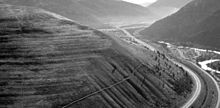Joseph Pardee
Joseph T. Pardee (born May 30, 1871 in Salt Lake City , Utah , † March 2, 1960 in Philipsburg , Montana ) was an American geologist . His work on the ice dam fractures of prehistoric Lake Missoula helped understand the origin of the Channeled Scablands .
Life
Joseph Pardee was born in Salt Lake City to James Knox Pardee and his wife Marie. At the age of three the family moved to Philipsburg, Montana. His father developed the Algonquin Mine east of Pittsburg. He was educated at the Presbyterian College of Montana at Deer Lodge . He later attended the University of California, Berkeley .
After completing his training, he set up a laboratory for the analysis of precious metals and ran a gold and sapphire mine . His growing interest in geology finally led to the United States Geological Survey (USGS for short) in 1909 , a scientific agency and the most important institute in the United States for official cartography , where he was employed until 1941.
Pardee was married to Ruby Estella Schoonover Pardee (1886-1976) since September 1, 1904. The couple had a daughter, Mary P. Pardee Kelly (1905-1994).
plant
During the 1920s, the geologist J Harlen Bretz suggested that the Channeled Scablands were created by mega-floods , in which enormous amounts of water must have appeared in a short time. The theory was vehemently rejected by other geologists, partly because Bretz could not provide an explanation for the origin of such water masses.
Pardee suggested that the break of an ice dam on Lake Missoula may have caused such a flood. From 1910 he studied the Scablands near Spokane and the intermontane basins of Montana. He found shorelines and other geomorphological evidence of a large ice reservoir near the city of Missoula . Lake Missoula comprised several intermontane basins with a water mass of about 2,000 cubic kilometers and could only be emptied via the Clark Fork River near the Idaho and Montana border.
However, he did not find direct evidence of a flood until the 1930s. In the northwest of Montan near Camas in Sanders County he discovered giant ripples with a height of 15 meters and a wavelength of 150 meters. The origin of these ripple marks could only be explained by a strong current, such as the rupture of an ice dam and the associated flood could create. Pardee pursued the idea for over 30 years and ultimately confirmed the connection between the existence of prehistoric Lake Missoula and the Missoula floods .
Web links
- Joseph Thomas Pardee and the Spokane Flood Controversy on gsahist.org
Individual evidence
- ^ Mary Pardee Kelly: Memorial to Joseph Thomas Pardee (1871-1960). In: Geological Society of America Bulletin. 74, 1963, p. 39, doi : 10.1130 / 0016-7606 (1963) 74 [P39: MTJTP] 2.0.CO; 2 .
- ^ Robert L. Fuchs: GSA Beneficiary of the Pardee and Kelly Estates In: GSA Today. Volume 5, No. 9, September 1995. ISSN 1052-5173 .
- ↑ JT Pardee: The Glacial Lake Missoula . In: The Journal of Geology , 18, No. 4, 1910, pp. 376-386
- ^ JT Pardee: Unusual currents in Glacial Lake Missoula, Montana. In: Geological Society of America Bulletin. 53, 1942, p. 1569, doi: 10.1130 / GSAB-53-1569 .
- ^ Victor R. Baker : The Channeled Scabland: A Retrospective. In: Annual Review of Earth and Planetary Sciences. 37, 2009, p. 393, doi: 10.1146 / annurev.earth.061008.134726 .
| personal data | |
|---|---|
| SURNAME | Pardee, Joseph |
| ALTERNATIVE NAMES | Pardee, Joseph T .; Pardee, Joe; Pardee, Joseph Thomas |
| BRIEF DESCRIPTION | American geologist |
| DATE OF BIRTH | May 30, 1871 |
| PLACE OF BIRTH | Salt Lake City , Utah |
| DATE OF DEATH | March 2, 1960 |
| Place of death | Philipsburg , Montana |


